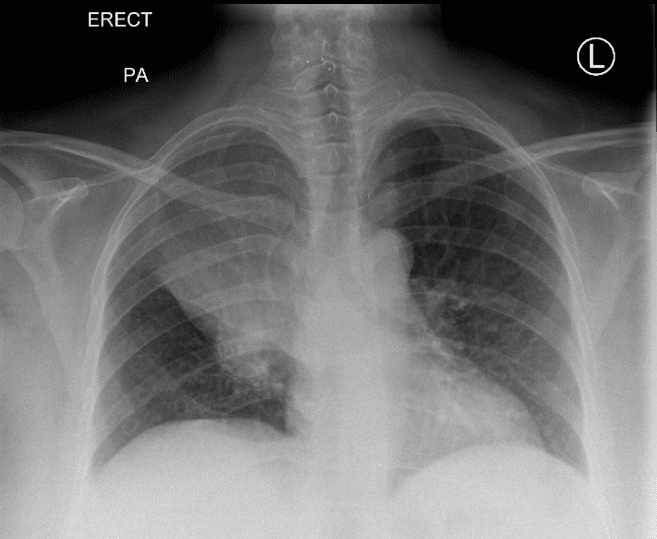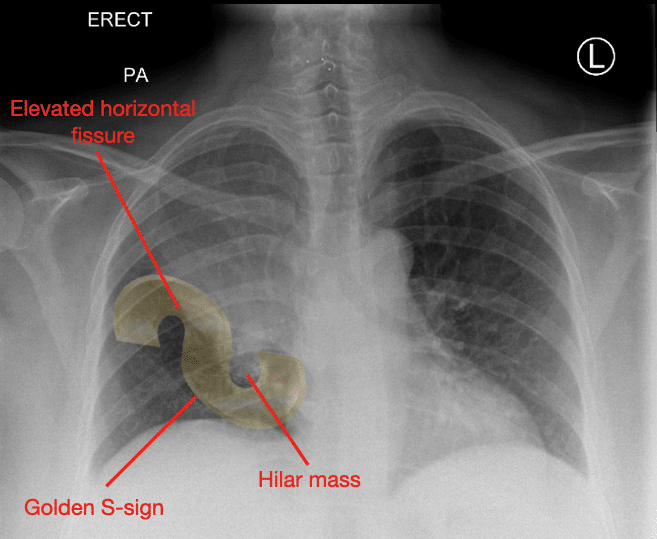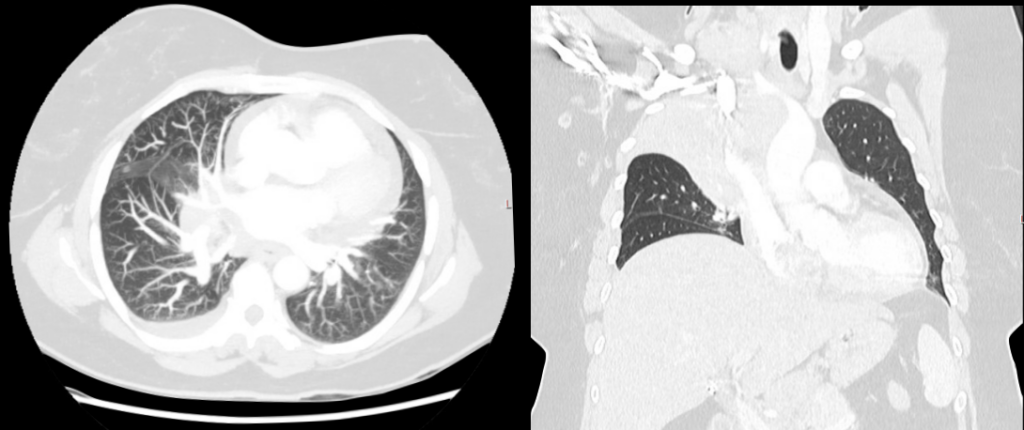CT Case 007
A 45yo female presents to ED with niggling chest and epigastric discomfort.
A CXR is performed which yields an unexpected finding.

Describe and interpret the CXR
CXR INTERPRETATION
There is right upper lobe collapse as well as a round opacity in the right hilum.
This is an X-ray finding known as the ‘Golden S Sign’ (actually a reverse S), named after radiologist Ross Golden (1889-1975).
Admittedly you have to use your eye of faith to really see the S shape here.
As the right upper lobe collapses completely the horizontal fissure becomes more concave, the edge produced by the elevated horizontal fissure and the hilar mass forms the reverse S shape.
When we see this sign, it raises suspicion for a hilar mass (usually a bronchial carcinoma) causing obstructive atelectasis of the right upper lobe. When the bronchus is obstructed, there will be variable air resorption and fluid retention leading to varying degrees of volume loss.

The patient went on to have a CT scan of the thorax

Describe and interpret the CT scan images
CT INTERPRETATION
There is incomplete atelectasis of RUL (drowned) due to RUL bronchus obstruction (as suspected on the CXR).
There is bulky confluent right hilar, mediastinal and supraclavicular lymphadenopathy.
There is NO pulmonary mass seen.
There are small pericardial and right pleural effusions.
A CT abdomen (not shown here) also shows extensive bulky lymphadenopathy.

CLINICAL CORRELATION
This CT scan shows a less common cause of the ‘Golden S Sign’
The appearance of extensive lymphadenopathy above and below the diaphragm is highly suspicious for lymphoma.
Our patient subsequently had a biopsy of supraclavicular lymph nodes, this confirmed the diagnosis of high-grade B cell lymphoma, and she is currently undergoing chemotherapy.
REFERENCES
- Golden R. The effect of bronchostenosis upon the roentgen-ray shadow in carcinoma of the bronchus. The American Journal of Roentgenology and Radium Therapy. 1925; 13: 21-31
- Rasuli B. Golden S-sign (lung lobe collapse). Radiopaedia 2021
- Gomez A, Cadogan M. Ross Golden (1889 – 1975). LITFL
- Gomez A, Cadogan M. Golden S sign. LITFL
[cite]
TOP 100 CT SERIES
Sydney-based Emergency Physician (MBBS, FACEM) working at Liverpool Hospital. Passionate about education, trainees and travel. Special interests include radiology, orthopaedics and trauma. Creator of the Sydney Emergency XRay interpretation day (SEXI).
Dr Leon Lam FRANZCR MBBS BSci(Med). Clinical Radiologist and Senior Staff Specialist at Liverpool Hospital, Sydney
Emergency Medicine Education Fellow at Liverpool Hospital NSW. MBBS (Hons) Monash University. Interests in indigenous health and medical education. When not in the emergency department, can most likely be found running up some mountain training for the next ultramarathon.



